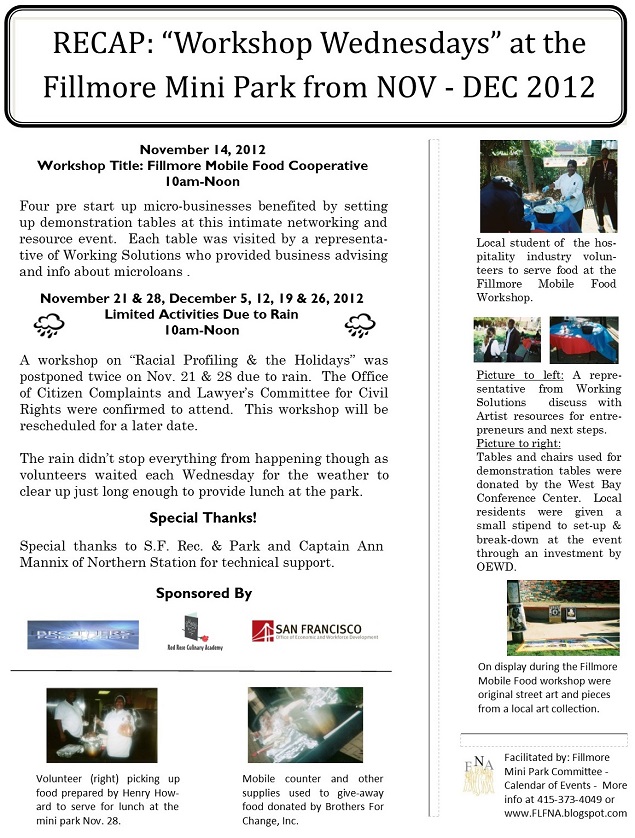MINUTES – October 18, 2012
(Meeting with Supervisor Christina
Olague’s Office)
Hosted by the Fillmore Neighborhood
Association
City Officials Present:
- Dominica Henderson, Legislative Aide of Supervisors Olague’s Office
Northern Police Station
Action Items:
a. Schedule Meeting with DCYF and
Director of Violence Prevention at the Mayor’s Office to find out more about
the Theory of Change, Circle of Care, Local Action Plan and the Mayor’s Interrupt,
Predict and Organize initiative.
General Meeting Discussion:
- The Mayor’s Office announced on 10/10/12 Diana Oliva-Aroche as Director of Violence Prevention Services
- San Francisco’s Juvenile Justice Coordinating Council - Juvenile Justice Local Action Plan:
- DCYF’s Theory of Change and the “Circle of Care” Model:
- DCYF’s Next Steps for Violence Prevention:
- DCYF’s Conclusion on Violence:
- Other Meeting Notes:
General Meeting Discussion
1)
The Mayor’s Office announced on 10/10/12 Diana Oliva-Aroche as Director of
Violence Prevention Services:
Diana Oliva-Aroche will organize the
community and City agencies in the Mayor’s Interrupt, Predict & Organize
(IPO) initiative for the Department of Children, Youth & Their Families
(DCYF).
2) San Francisco’s Juvenile Justice Coordinating Council - Juvenile Justice Local Action Plan:
In 2007, San Francisco completed a local
Violence Prevention Plan that outlines a comprehensive and strategic approach
to juvenile and criminal justice efforts. In addition to focusing on the needs
of youth 18 and under, the plan underscored the needs of at-risk transitioning
youth (ages 18-25) who often face obstacles that make them vulnerable to entry
or reentry into the criminal justice system. As such, the plan acknowledges San
Francisco’s responsibility to create strategies and safety nets for
transitioning youth.
3) DCYF’s Theory of Change and the
“Circle of Care” Model:
DCYF’s Violence
Prevention and Intervention “theory of change” will inform the plan’s funding
framework. The theory of change shows the series of changes that lead to the
desired outcome, and includes changes that are difficult to measure. The theory
of change underlies all DCYF’s violence prevention and intervention work.
Figure 1 outlines the stages of the theory of change.
4) DCYF’s Next Steps for Violence Prevention:
DCYF will
next work with the Mayor’s office and current partners (including DCYF) on
developing a fully revised, citywide Violence Prevention Plan targeted towards
all residents and visitors in San Francisco. This third phase of the revision
process should incorporate the work and expertise of City planning councils
such as the Family Violence Council and the Reentry Council. Building a Plan
that uses other City strategic plans and reports will help increase
coordination, and ensure that each City agency builds on its core content
expertise and community connections.
5) DCYF’s Conclusion on Violence:
Youth and
young adults, particularly those from communities of color and low income
communities, are disproportionately affected by violence in San Francisco.
Young people between the ages of 10 and 25 years old may experience a range of
adverse consequences as a result of experiencing or participating in violence.
This plan endeavors to interrupt the cycle of violence and increase
coordination among agencies that fund violence prevention work in San
Francisco.
6)
Other Meeting Notes:
There is desire for visible among Police
Officers. Very few beat cops now. Beat cops and community policing got violence
down.
There are specific police at housing
sites through community policing;
Public to work with the Police Chief;
Police are response;
Police are expected to do a lot
The Community Response Network (CRN) is
prevention and response;
Who is plan coming from?
Develop relationships between residents,
CBOs and Police Stations to help people feel safe, but also safe from police
harassment.
There are a lot of I Phone Thefts.




